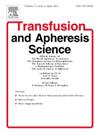The prevalence and pattern of alloimmunization in patients with sickle cell disease in Abuja, Nigeria
IF 1.4
4区 医学
Q4 HEMATOLOGY
引用次数: 0
Abstract
Background
One of the components of comprehensive care and interventions in managing patients with sickle cell disease (SCD) is red blood cell transfusion. This has helped in reducing the morbidity and mortality associated with SCD. Individuals who undergo multiple red cell transfusions are faced with alloimmunization which makes it difficult to source compatible blood for them. This often leads to haemolytic reactions and sometimes death of the patients. In this study, we determined the prevalence and pattern of alloimmunization in patients with SCD.
Methods
This was a cross-sectional study of 205 patients with SCD aged 1–45 years, attending the sickle cell clinic at the University of Abuja Teaching Hospital, Gwagwalada, Abuja. Antibody detection and identification were done using the tube technique (Lone Laboratories UK). The data was analyzed and reported in percentages and descriptive statistics.
Results
Of the 205 participants, 115 (56.1 %) were males while 90 (43.9 %) were females. 99 (48.8 %) of the patients had been transfused two or more times while 49(23.9 %) were transfused only once. Fifty-seven (27.8 %) participants have never had a transfusion. The following blood group systems were observed in 26 alloimmunized SCD participants; Rh (D/E/e/C/Cw) 46 %, Kell19.2 %, Lewis 11.5 %, MNS 3.8 %, Duffy 23.0 %. All 26 participants have had more than one episode of blood transfusion.
Conclusion
The prevalence rate was 17.6 % and Rh alloantibodies were common among patients with SCD who have received multiple transfusions. Proper blood detection and identification of alloantibodies should be promoted before blood transfusion to manage these patients better.
尼日利亚阿布贾镰状细胞病患者异体免疫的流行和模式
背景:镰状细胞病(SCD)患者综合护理和干预措施的组成部分之一是红细胞输血。这有助于降低与SCD相关的发病率和死亡率。接受多次红细胞输注的个体面临同种异体免疫,这使得他们难以获得相容的血液。这通常会导致溶血反应,有时甚至导致患者死亡。在这项研究中,我们确定了SCD患者的异体免疫的患病率和模式。方法:本研究是一项横断面研究,纳入205例1-45岁的SCD患者,这些患者在阿布贾Gwagwalada的阿布贾大学教学医院镰状细胞门诊就诊。抗体检测和鉴定采用试管技术(Lone Laboratories UK)。数据以百分比和描述性统计进行分析和报告。结果205名参与者中,男性115名(56.1% %),女性90名(43.9% %)。2次及以上输血者99例(48.8 %),1次输血者49例(23.9 %)。57名(27.8 %)参与者从未输血。在26名异体免疫的SCD参与者中观察了以下血型系统:Rh (D / E / E / C / Cw) 46 %,Kell19.2 %,刘易斯11.5 %,MNS 3.8 %,达菲23.0 %。所有26名参与者都有过一次以上的输血经历。结论SCD多次输血患者Rh异体抗体阳性率为17.6 %,Rh异体抗体在SCD患者中普遍存在。在输血前应提倡适当的血液检测和鉴定同种异体抗体,以更好地管理这些患者。
本文章由计算机程序翻译,如有差异,请以英文原文为准。
求助全文
约1分钟内获得全文
求助全文
来源期刊
CiteScore
3.60
自引率
5.30%
发文量
181
审稿时长
42 days
期刊介绍:
Transfusion and Apheresis Science brings comprehensive and up-to-date information to physicians and health care professionals involved in the rapidly changing fields of transfusion medicine, hemostasis and apheresis. The journal presents original articles relating to scientific and clinical studies in the areas of immunohematology, transfusion practice, bleeding and thrombotic disorders and both therapeutic and donor apheresis including hematopoietic stem cells. Topics covered include the collection and processing of blood, compatibility testing and guidelines for the use of blood products, as well as screening for and transmission of blood-borne diseases. All areas of apheresis - therapeutic and collection - are also addressed. We would like to specifically encourage allied health professionals in this area to submit manuscripts that relate to improved patient and donor care, technical aspects and educational issues.
Transfusion and Apheresis Science features a "Theme" section which includes, in each issue, a group of papers designed to review a specific topic of current importance in transfusion and hemostasis for the discussion of topical issues specific to apheresis and focuses on the operators'' viewpoint. Another section is "What''s Happening" which provides informal reporting of activities in the field. In addition, brief case reports and Letters to the Editor, as well as reviews of meetings and events of general interest, and a listing of recent patents make the journal a complete source of information for practitioners of transfusion, hemostasis and apheresis science. Immediate dissemination of important information is ensured by the commitment of Transfusion and Apheresis Science to rapid publication of both symposia and submitted papers.

 求助内容:
求助内容: 应助结果提醒方式:
应助结果提醒方式:


